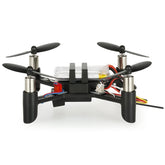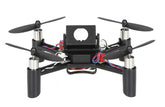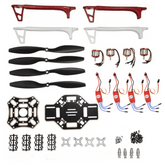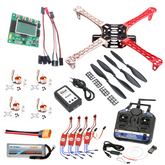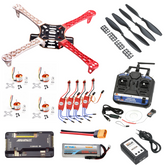How to Build Your Own Drone
Summary
Dive into the exhilarating world of DIY drone building with our comprehensive blog, "How to Build Your Own Drone." Begin with an insightful introduction, followed by a breakdown of the basics and crucial tips for planning your drone project. Discover the art of selecting the right components, master the assembly process, and delve into the intricate realms of programming and calibration. Uncover expert insights on resolving common DIY drone building issues. Conclude your journey with a compelling conclusion that leaves you ready to take flight into the exciting realm of personalized drone creation. Embark on your drone-building adventure now!
Introduction
Welcome to the Exciting World of DIY Drone Building! In recent years, there has been a remarkable surge in the fascination for building personal drones. Enthusiasts, driven by a desire for customization and a hands-on approach, are increasingly drawn to the prospect of crafting their aerial companions.
Build the perfect drone with our Drone Parts List guide!
Unlocking Benefits
Cost Savings
Building your own drone presents a compelling financial advantage. As opposed to purchasing pre-built drones, the DIY route allows you to optimize costs, ensuring each component aligns with your budget without compromising quality.
Customization
The allure of customization goes beyond aesthetics. With a DIY approach, you can tailor your drone to meet specific features and specifications, creating a unique gadget that caters precisely to your needs and preferences.
Learning Experience and Skill Development
Building a drone isn't just a hobby; it's a journey of skill development. Engaging in the intricate world of electronics and engineering provides a valuable learning experience, fostering a deeper understanding of the technology.

Who Is This For?
Technology Enthusiasts
For those captivated by the ever-evolving world of technology, DIY drone building offers a thrilling avenue to explore and apply their passion.
Drone Hobbyists
Hobbyists seeking a more hands-on and personalized experience in the realm of drones will find a fulfilling endeavor in crafting their own aerial devices.
Personalized Solution Seekers
Individuals in search of a drone that aligns perfectly with their unique needs and preferences will discover the satisfaction of creating a personalized solution from scratch.
Embark on this journey with us as we delve into the intricacies of building your own drone, from selecting components to mastering the assembly process. The sky's the limit, and we're here to guide you through every step of the way.
Understanding the Basics
Delving into the world of DIY drone building requires a solid understanding of the fundamental components that form the backbone of these unmanned aerial vehicles. Let's unravel the essentials.
Frame, Motors, and Propellers

In the realm of drone construction, the frame serves as the structural foundation. Various frame types, from quadcopters to hexacopters, each offer unique advantages in terms of stability and maneuverability. Motors, the powerhouse of your drone, propel it through the skies, while propellers contribute to aerodynamics.
Learn how to pick the right drone propeller for your flight style.

Flight Controller and Electronic Speed Controllers (ESCs)
At the heart of drone navigation is the flight controller, a sophisticated electronic system that interprets your commands and stabilizes the drone during flight.

Electronic Speed Controllers (ESCs) regulate the speed of individual motors, ensuring a harmonious and controlled flight experience.

Equipping Your Drone Workshop
Arming yourself with the right tools is crucial for a smooth assembly process. Let's explore the tools and equipment that will pave the way for a successful DIY drone project.
Necessary Tools for Drone Assembly
- Screwdrivers and Wrenches: Essential for securing components to the frame.
- Soldering Iron: Needed for connecting electrical components securely.
- Wire Strippers: Ensures clean and precise wire connections.
- Multimeter: Helps in checking voltage, continuity, and resistance.
- Tweezers and Pliers: Aids in handling small components with precision.
Safety Precautions in Handling Tools
- Eye Protection: Shield your eyes from soldering sparks and debris.
- Ventilation: Ensure a well-ventilated workspace to minimize fumes.
- Proper Storage: Store tools in an organized manner to prevent accidents.
Mastering these basics sets the stage for a seamless drone building journey.
Planning Your Drone Build
Crafting Your Drone Vision Embarking on the journey of building your own drone begins with a strategic plan to ensure your aerial creation aligns seamlessly with your desires and needs.
Identifying Purpose and Requirements
- Photography or Racing? - Determine the primary use of your drone. Is it for capturing breathtaking aerial shots or participating in exhilarating racing events?
- Surveillance or Leisure? - For those seeking surveillance capabilities, outline the required features. Alternatively, if leisure is the goal, specify the desired functionalities for a relaxed flying experience.
Tailoring Technical Requirements
Camera Specifications (If for Photography) - Define camera resolution, stabilization features, and any additional features crucial for capturing high-quality aerial images.
Speed and Maneuverability (If for Racing) - Specify the desired speed capabilities and maneuverability, considering the requirements of competitive racing environments.
Selecting the Right Components
Engineering Your Drone's Foundation The success of your DIY drone project hinges on the thoughtful selection of key components that form the backbone of your aerial creation. In this chapter, we explore the critical decisions behind frame and design selection, laying the groundwork for a high-performing and visually appealing drone.
Frames
- Quadcopter Frames - Recognized for stability and simplicity, quadcopter frames are ideal for beginners and aerial photography enthusiasts.
- Hexacopter and Octocopter Frames - Offering increased lifting capacity, these frames are suitable for heavy payloads or advanced applications.
- Fixed-Wing Frames - Ideal for long-range flights and efficient battery usage, fixed-wing frames are popular in mapping and surveillance drones.

Design Considerations for Aerodynamics and Functionality
Streamlined Designs - Consider aerodynamic shapes to reduce air resistance, enhancing overall flight efficiency.
Payload Accommodation - Evaluate the design's capability to integrate additional equipment, such as cameras or sensors, without compromising stability.
Motor and Propellers
- Understanding Motor Specifications - Factors like KV rating and torque influence the motor's performance. Match these specifications with your drone's requirements.
- Propeller Selection for Optimal Performance - Different propeller sizes and pitches affect thrust and efficiency. Choose propellers that complement your chosen motors for balanced flight characteristics.
Ensuring Optimal Combinations
- Balancing Power and Weight - Calculate the power-to-weight ratio to ensure your drone achieves the desired performance without unnecessary strain on the motors.
- Considering Flight Style - Tailor motor and propeller combinations to match your intended use, whether it's agile racing or stable aerial photography.
By understanding the intricacies of frame design and the harmony between motors and propellers, you lay the groundwork for a drone that not only soars through the skies but does so with precision and efficiency. The next chapter will guide you through the step-by-step assembly process, bringing your carefully selected components together into a functional whole.
Assembly Process
With the meticulously selected components in hand, it's time to embark on the thrilling journey of assembling your very own drone. This chapter serves as your comprehensive guide, providing step-by-step instructions for a seamless and successful assembly process.
- Frame Assembly - Begin by connecting the frame components, ensuring a sturdy foundation for the rest of the drone. Follow the manufacturer's guidelines for optimal structural integrity.
- Electronic Component Integration - Carefully install the motors, flight controller, electronic speed controllers (ESCs), and other crucial components onto the frame. Pay attention to the wiring layout for efficient functionality.
- Battery Mounting - Securely attach the battery to the designated space on the frame, considering weight distribution and accessibility for future replacements.

Cable Management for a Clean Build
Organizing Wires - Tidy up the wiring to avoid interference and potential malfunctions. Utilize cable ties or clips to secure wires along the frame and prevent entanglement.
Connection Checks - Before proceeding, double-check all connections to ensure proper alignment. Address any loose connections or discrepancies in the wiring.
Testing and Troubleshooting
- Power-Up Sequence - Gradually power up the drone, checking for any unusual sounds or vibrations. Immediate troubleshooting may be necessary if irregularities occur.
- Motor Testing - Verify the functionality of each motor individually. Ensure they spin in the correct direction and at the expected speed.
Addressing Common Assembly Hiccups
- Flight Controller Calibration - Calibrate the flight controller to ensure accurate sensor readings. Follow the calibration process outlined in the manufacturer's instructions.
- Testing Stability - Conduct hover tests in a controlled environment to assess the drone's stability and responsiveness. Make necessary adjustments to the flight controller settings.
As you navigate the assembly process, remember that patience and attention to detail are key. The next chapter will guide you through the intricate world of programming and calibration, transforming your drone from a collection of parts into a finely tuned flying machine.
Visit our Drone Parts collection page for build on your own.
Programming and Calibration
Flight Controller Programming Demystified Embarking on the journey of drone assembly opens up the realm of digital intricacies. In this chapter, we delve into the heart of drone functionality the flight controller. Understanding and programming this digital maestro is crucial for achieving stability and control in your DIY aerial creation.
Flight Controller Software
- Open Source vs. Proprietary Software - Explore the options between open-source flight controller software like Betaflight or Cleanflight and proprietary solutions. Consider the features and user-friendliness of each.
- Selecting the Right Software for Your Drone - Tailor your choice based on the drone's purpose. Photography drones may require different features compared to racing drones. Choose software that aligns with your goals.
Basic Programming Steps for Stabilization and Control
Understanding PID (Proportional, Integral, Derivative) Controllers - Grasp the basics of PID controllers, the backbone of drone stabilization. Learn how to adjust these parameters to achieve the desired balance.
Setting Up Flight Modes - Configure different flight modes for diverse scenarios. Whether you're capturing breathtaking landscapes or participating in a racing competition, having the right mode enhances your drone's performance.
Calibration Process
- Ensuring Accurate Sensor Readings - Step through the calibration process to eliminate any discrepancies in sensor readings. A well-calibrated drone responds accurately to external stimuli.
- Fine-Tuning for Stability - Dive into the intricacies of fine-tuning settings for a stable and responsive flight experience. Adjust parameters to match your flying preferences and environmental conditions.
By mastering the art of flight controller programming and calibration, you're not only elevating the performance of your drone but also gaining a deeper understanding of the technological marvel that takes your creation to the skies.
Get your FlySky FS-i6 at the lowest price ever!
Find the perfect DIY Drone Kit for your next project.
Resolving Common Issues in DIY Drone Building
In this chapter, we delve into the intricacies of DIY drone assembly by focusing on identifying and resolving common issues encountered during the build process. Troubleshooting is a crucial skill that ensures your drone takes flight seamlessly.
Cable Management Tips
- Organizing Power Cables - Securely fasten power cables to prevent interference and ensure a stable power supply. Neatly organize cables to avoid entanglements and potential malfunctions.
- Separation of Signal and Power Cables - Understand the importance of separating signal and power cables to prevent signal interference. Learn effective routing techniques for maintaining a clean and efficient build.
Troubleshooting Electronic Components
- Identifying Faulty Motors - Learn to diagnose and address motor issues such as irregular spinning or failure to start. Troubleshoot motor connections and ESC configurations for optimal performance.
- Flight Controller Calibration Challenges - Understand the nuances of flight controller calibration. Troubleshoot sensor calibration issues, ensuring your drone responds accurately to control inputs.
Testing
- Pre-Flight Testing Protocols - Establish a pre-flight testing routine to verify the functionality of individual components. Address any anomalies before takeoff to prevent mid-air surprises.
- Real-Time Troubleshooting - Implement real-time troubleshooting techniques during tests. Learn to identify issues with motors, propellers, and the flight controller promptly.
Conclusion
Embarking on the journey of building your own drone is a thrilling endeavor that combines technical knowledge, creativity, and a passion for aviation. From grasping the basics to meticulously selecting components, our guide has navigated you through each step of the process. As you embark on the assembly and programming phases, remember that overcoming challenges is part of the learning curve. By troubleshooting common issues, you'll refine your skills. Now, armed with a DIY drone and newfound expertise, take flight into the world of innovation and exploration. Happy droning! Ready to soar? Dive into the exciting world of DIY drone building now!



